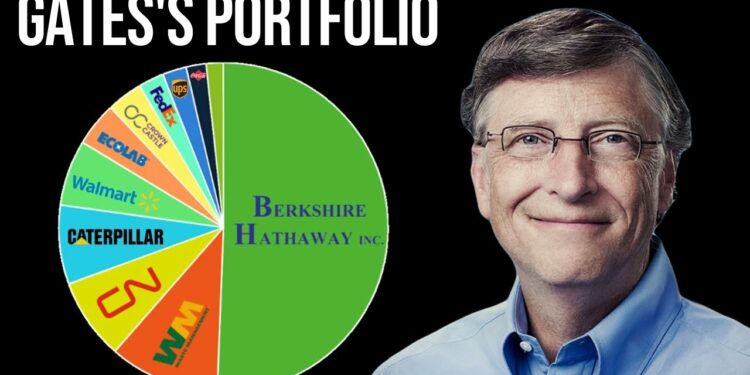First Published on February 24th, 2023 by Bob Ciura for SureDividend
Bill Gates is the fourth-richest person in the world, behind only Jeff Bezos, Elon Musk, and Bernard Arnault. His net worth of ~$129 billion is a massive amount of money. Not surprisingly, the Bill & Melinda Gates Foundation has a huge investment portfolio above $35 billion according to a recent 13F filing.
That kind of wealth is something the vast majority of us can only dream of. However, there is one similarity between the everyday investor and the wealthiest person on the planet.
We’re all looking for good stocks to buy and hold for the long-term. That is why it is useful to review the stock holdings of the Bill & Melinda Gates Foundation.
You can download our full list of all 22 Gates Foundation stocks (along with important metrics like dividend yields and price-to-earnings ratios) by clicking on the link below:

Note: 13F filing performance is different than fund performance. See how we calculate 13F filing performance here.
The Bill & Melinda Gates Foundation owns several highly profitable companies, with sustainable competitive advantages. Many of the stocks also pay dividends to shareholders, and grow their dividend payouts over time.
This article will discuss the 22 stocks held by the Bill & Melinda Gates Foundation.
In this article
Table of Contents
You can skip to the analysis for each of the Gates Foundation’s 22 stock holdings, with the table of contents below. Stocks are listed in order of the portfolio’s largest positions to smallest positions.
- Microsoft (MSFT)
- Berkshire Hathaway (BRK.B)
- Canadian National Railway (CNI)
- Waste Management (WM)
- Caterpillar Inc. (CAT)
- Deere & Company (DE)
- Ecolab (ECL)
- Walmart (WMT)
- Coca-Cola FEMSA, S.A.B. de C.V. (KOF)
- Waste Connections (WCN)
- FedEx Corp. (FDX)
- Crown Castle International (CCI)
- Coupang, Inc. (CPNG)
- Schrodinger, Inc. (SDGR)
- United Parcel Service, Inc. (UPS)
- Madison Square Garden Sports Corp. (MSGS)
- Kraft Heinz (KHC)
- Hormel Foods (HRL)
- Danaher Corporation (DHR)
- On Holding AG (ON)
- Carvana Co. (CVNA)
- Vroom, Inc. (VRM)
You can also watch video analysis of Gates’ stock holdings below:https://www.youtube.com/embed/JiTgMqWWuho
#1—Microsoft
Dividend Yield: 1.0%
Percentage of Bill Gates’ Portfolio: 26.4%
Microsoft Corporation, founded in 1975 and headquartered in Redmond, WA, develops, manufactures and sells both software and hardware to businesses and consumers. Microsoft is a mega-cap stock with a market capitalization of $1.8 trillion.
Its offerings include operating systems, business software, software development tools, video games and gaming hardware, and cloud services.
In late January, Microsoft reported (1/24/23) financial results for the second quarter of fiscal 2023 (Microsoft’s fiscal year ends June 30th). The company grew its revenue 2% over last year’s quarter. Growth came from Intelligent Cloud and Productivity & Business Processes, which grew 22% and 7%, respectively. Sales of Azure, Microsoft’s high-growth cloud platform, grew 31%. On the other hand, Personal Computing saw its revenue decrease -19%.
Moreover, due to a strong dollar, which reduced earnings from international markets, adjusted earnings-per-share dipped -6%, from $2.48 to $2.32.
Click here to download our most recent Sure Analysis report on Microsoft (preview of page 1 of 3 shown below):
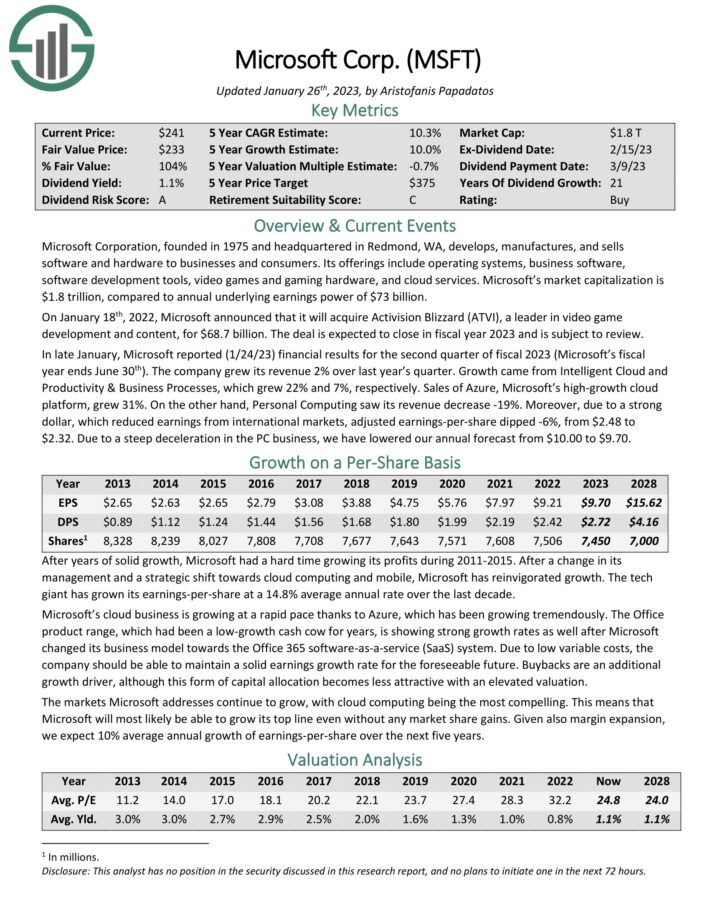
#2—Berkshire Hathaway
Dividend Yield: N/A (Berkshire Hathaway does not currently pay a dividend)
Percentage of Bill Gates’ Portfolio: 21.3%
Berkshire Hathaway stock is the second-largest individual holding of the Gates Foundation’s investment portfolio, and it is easy to see why. It’s safe to say the money is in good hands. Berkshire, under the stewardship of Warren Buffett, grew from a struggling textile manufacturer, into one of the largest conglomerates in the world.
Today, Berkshire is a global giant. It owns and operates dozens of businesses, with a hand in nearly every major industry including insurance, railroads, energy, finance, manufacturing, and retailing. It has a market capitalization above $600 billion.
Berkshire can be thought of in five parts: wholly owned insurance subsidiaries like GEICO, General Re and Berkshire Reinsurance; wholly-owned non-insurance subsidiaries like Dairy Queen, BNSF Railway, Duracell, Fruit of the Loom, NetJets, Precision Cast Parts and See’s Candies; shared control businesses like Kraft Heinz (KHC) and Pilot Flying J; marketable publicly-traded securities including significant stakes in companies like American Express (AXP), Apple (AAPL), Bank of America (BAC), Coca-Cola (KO) and Wells Fargo (WFC); and finally the company’s cash position.
In Berkshire’s annual letters to shareholders, Buffett typically evaluates the company’s performance in terms of book value. Book value is an accounting metric that measures a company’s assets minus its liabilities. The resulting difference is a company’s book value. This is a proxy for the intrinsic value of a firm, which Buffett believes to be the most important financial metric.
Berkshire doesn’t pay a dividend to shareholders. Buffett and his partner Charlie Munger have always contended that they can create wealth at a higher rate than the dividend would provide to shareholders.
While Berkshire stock may not be attractive for investors who want dividend income, there are few companies that have a track record nearly as great as Berkshire’s.
#3—Canadian National Railway
Dividend Yield: 2.0%
Percentage of Bill Gates’ Portfolio: 18.2%
Canadian National Railway is the only transcontinental railroad in North America. It has a network of approximately 20,000 route miles and connects three coasts: the Atlantic, the Pacific and the Gulf of Mexico. It handles over $200 billion worth of goods annually and carries over 300 million tons of cargo.
On January 24th, 2023, Canadian National Railway increased its dividend 3.1% for the March 31st, 2023 payment date.
Also on January 24th, 2023, Canadian National Railway announced fourth quarter and full year results for the period ending December 31st, 2022. For the quarter, revenue grew 14.2% to $3.4 billion, beating estimates by $49.4 million. Adjusted earnings-per-share of $1.57 compared to $1.35 in the prior year and was $0.02 higher than expected. For the year, revenue grew 12% to $13 billion while adjusted earnings-per-share of $5.67 compared to $4.75 in 2021.
For the quarter, Canadian National Railway’s operating ratio improved 40 basis points to 57.9%. Revenue ton miles (RTM) increased 6.3% to 60.1 billion. Revenues for all product categories were up at least 5%, led by strength in automotive (+48%), grain and fertilizers (+48%), coal (+42%), metals and minerals (+27%), and intermodal (+13%).
For the year, all product categories were up double-digits, led by gains in coal (+52%), automotive (+38%), metals and minerals (+23%), and intermodal (+19%). Car velocity improved 10%, terminal dwell was better by 9%, and fuel efficiency improved 1% during the quarter. Train length fell by 7%.
Canadian National Railway forecasts adjusted earnings-per-share will grow by a low single-digit percentage in 2023
versus the prior year.
Click here to download our most recent Sure Analysis report on Canadian National Railway (preview of page 1 of 3 shown below):
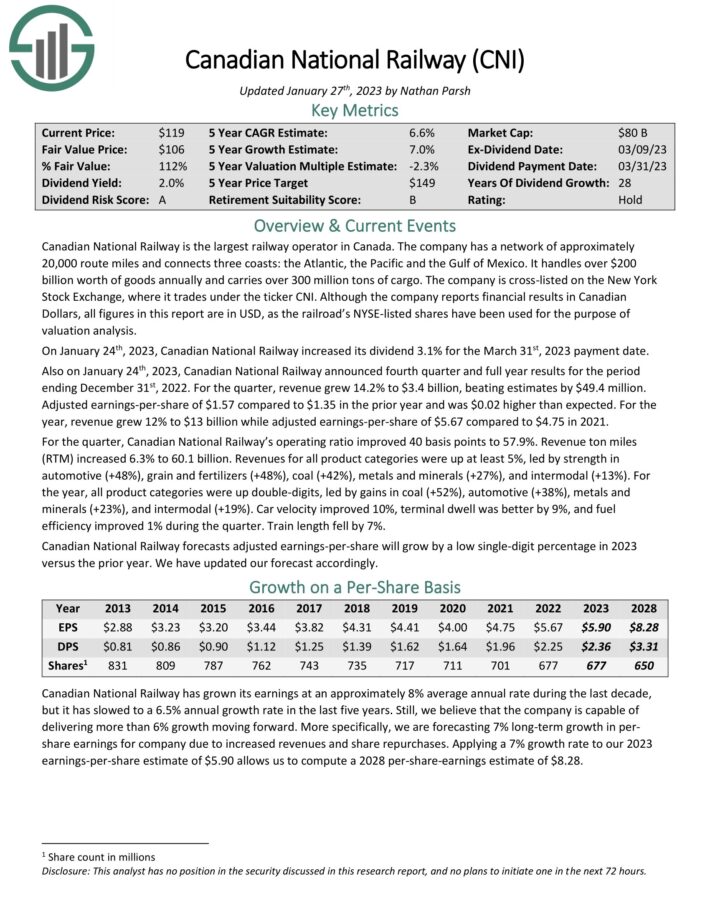
#4—Waste Management
Dividend Yield: 1.8%
Percentage of Bill Gates’ Portfolio: 15.4%
Waste Management is the embodiment of a company with a wide economic “moat”, a term popularized by Warren Buffett to describe a strong competitive advantage that protects a company from the full ravages of market competition. Waste Management operates in waste removal and recycling services. This is a highly-concentrated industry, with only a few companies controlling the majority of the market.
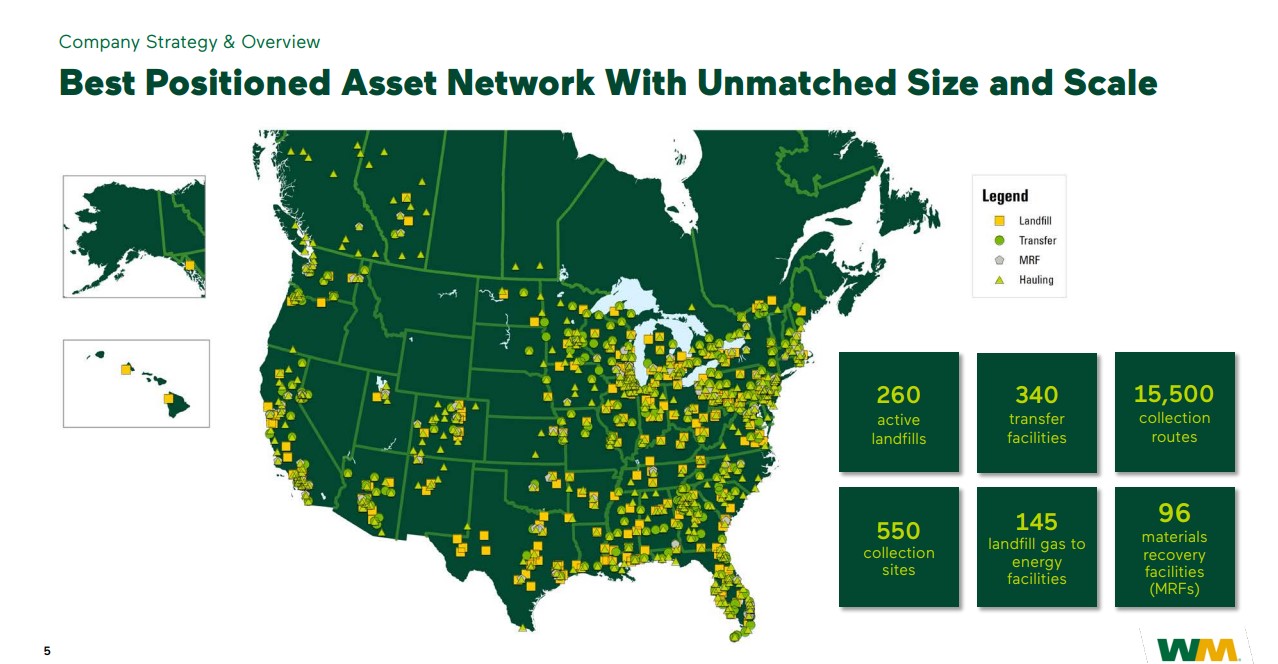
Source: Investor Presentation
On January 31st, 2023, Waste Management reported fourth quarter and full year results for the period ending December 31st, 2023. For the quarter, the company generated revenue of $4.94 billion, a 5.5% increase compared to Q4 2021. Adjusted net income equaled $537 million or $1.30 per share compared to $528 million or $1.26 per share in Q4 2021. Total company volumes decreased by nearly 1.0% in Q4 compared to an increase of 2.8% in the same prior year period.
For the full year, the company recorded adjusted earnings of $5.59 per share, a strong 15.5% increase compared to 2021. During 2022, Waste Management repurchased $1.5 billion of common stock. The company also returned $1.08 billion to shareholders in the form of cash dividends.
Click here to download our most recent Sure Analysis report on Waste Management (preview of page 1 of 3 shown below):
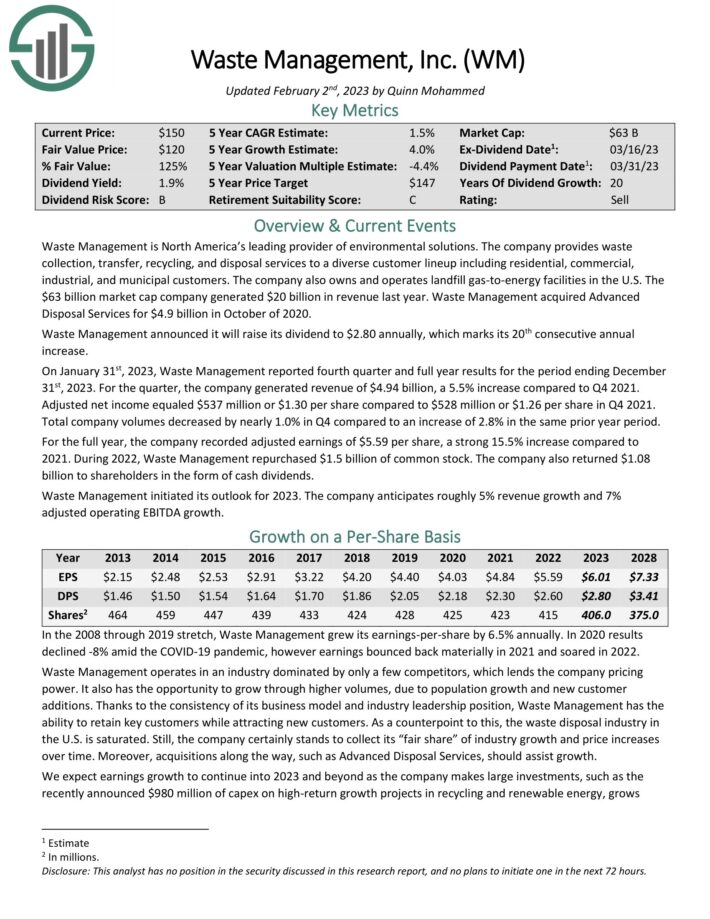
#5—Caterpillar
Dividend Yield: 2.0%
Percentage of Bill Gates’ Portfolio: 4.9%
Caterpillar is the global leader in heavy machinery. It has a strong brand with a dominant industry position. Caterpillar manufactures and markets heavy machinery, mostly for the construction and mining sectors.
The company operates in three primary segments: Construction Industries, Resource Industries and Energy & Transportation, along with ancillary financing and related services through its Financial Products segment.
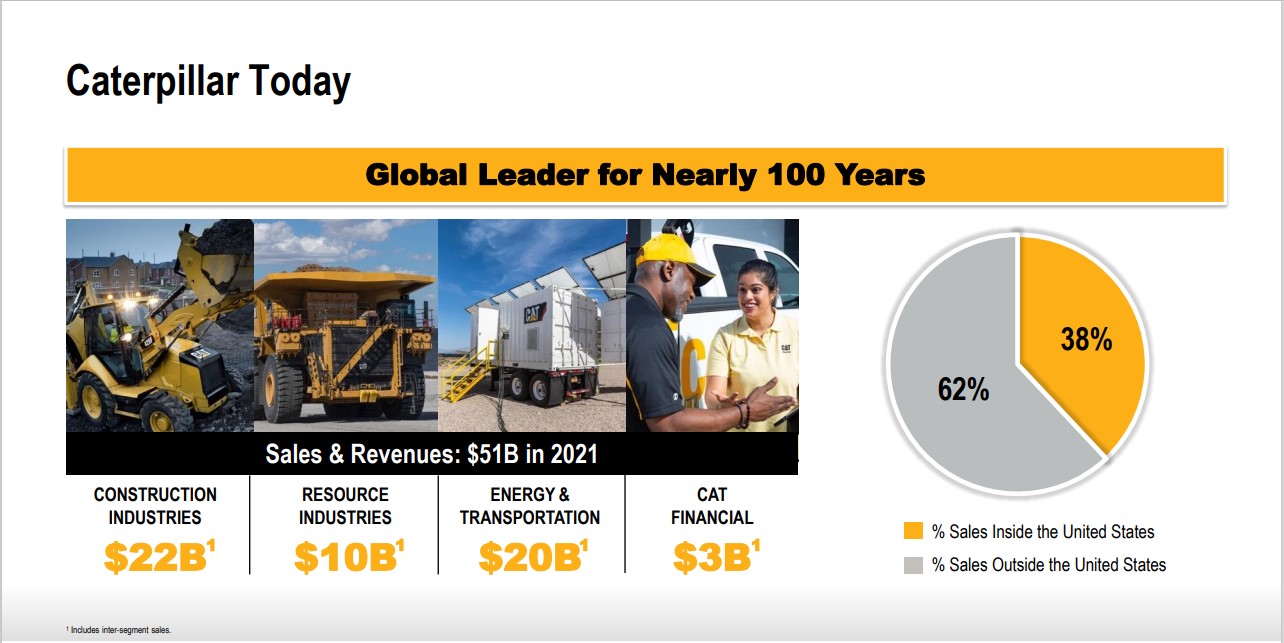
Source: Investor Presentation
On January 31st, 2023, Caterpillar reported its Q4 2022 and full-year results for the period ending December 31st, 2022. For the quarter, the company generated revenues of $16.6 billion, a 20% increase compared to the $13.8 billion posted in the fourth quarter of 2021. Construction Industries, Resource Industries, and Energy & Transportation posted growth of 19%, 26%, and 19%, respectively.
The increase was due to favorable price realization and higher sales volume, partially offset by unfavorable currency impacts primarily related to the euro, Japanese yen, and Australian dollar. The increase in sales volume was driven by changes in dealer inventories and higher equipment sales to end users. Dealers increased inventories by $700 million during the quarter, compared to remaining about flat during the prior-year period.
Caterpillar’s adjusted operating profit margin was 17%, compared to 11.4% last year. Margin expansion combined with revenue growth resulted in adjusted earnings-per-share landing at $3.86 against $2.69 in the comparable period last year, closing the year with great momentum in earnings-per-share growth.
Click here to download our most recent Sure Analysis report on Caterpillar (preview of page 1 of 3 shown below):
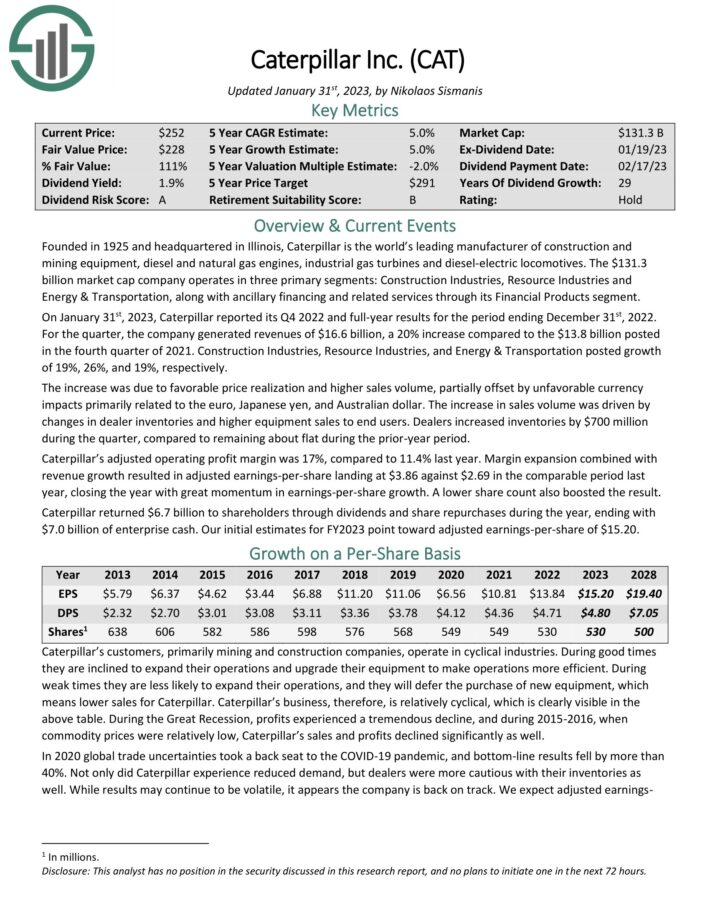
#6—Deere & Company (DE)
Dividend Yield: 1.2%
Percentage of Bill Gates’ Portfolio: 4.7%
Deere & Company is the largest manufacturer of farm equipment in the world. The company also makes equipment used in construction, forestry & turf care, produces engines and provides financial solutions to its customers. Deere was founded in 1837.
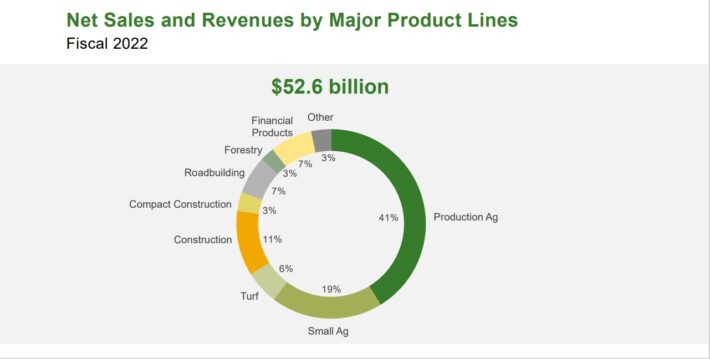
Source: Investor Presentation
In mid-August, Deere reported (8/19/22) financial results for the third quarter of fiscal 2022. The company grew its sales 25% over the prior year’s quarter thanks to high production growth. Sales grew across the board with the Production & Precision Ag, Small Ag & Turf and Construction & Forestry segments posting gains of 43%, 16%, and 8%, respectively.
Deere also grew its earnings-per-share 16%, from $5.32 to $6.16, but missed the analysts’ consensus by $0.53 due to high cost inflation and supply chain issues. Moreover, Deere narrowed its guidance for its annual earnings in 2022, from $7.0-$7.4 billion to $7.0-$7.2 billion. Nevertheless, Deere is doing its best to meet the exceptionally strong demand it enjoys for its products right now.
Click here to download our most recent Sure Analysis report on Deere (preview of page 1 of 3 shown below):
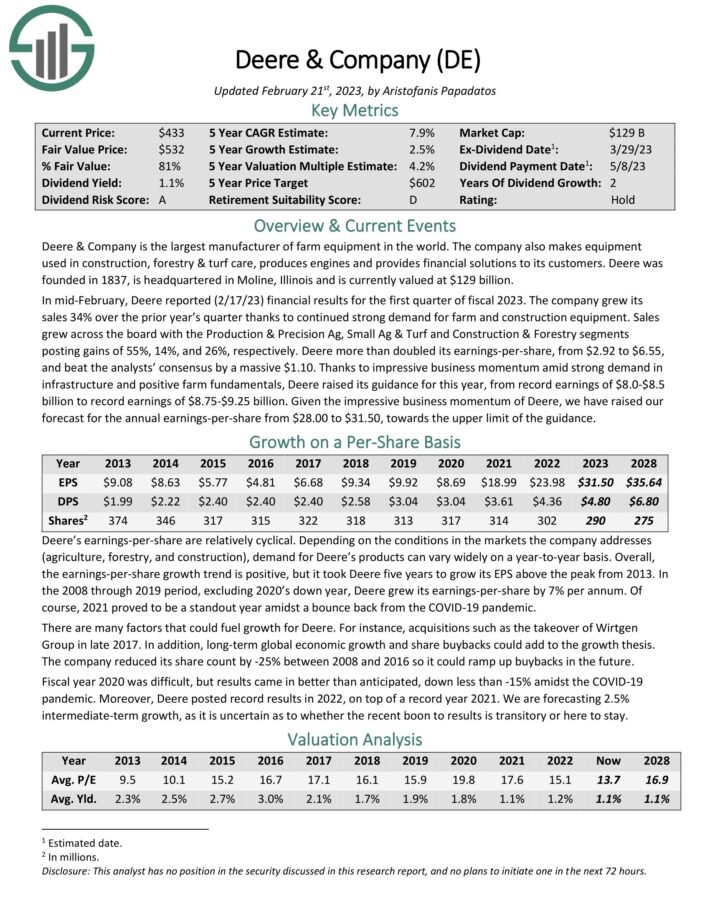
#7—Ecolab
Dividend Yield: 1.3%
Percentage of Bill Gates’ Portfolio: 2.1%
Ecolab was created in 1923, when its founder Merritt J. Osborn invented a new cleaning product called “Absorbit”. This product cleaned carpets without the need for businesses to shut down operations to conduct carpet cleaning. Osborn created a company revolving around the product, called Economics Laboratory, or Ecolab.
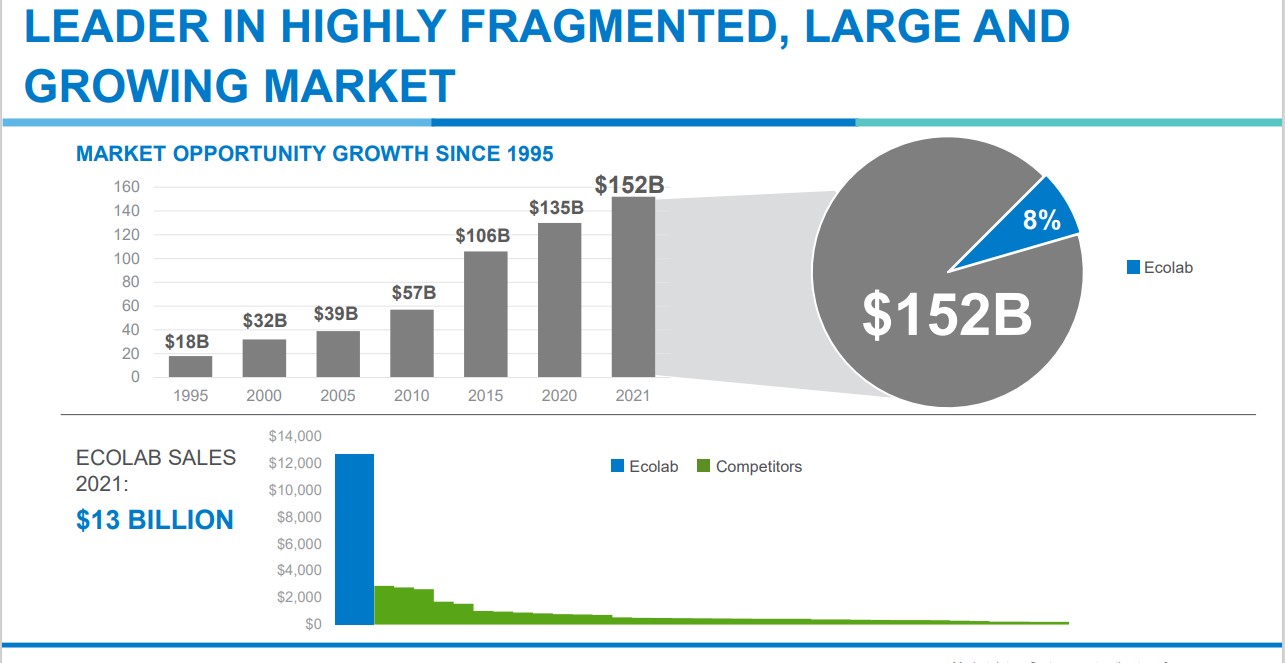
Source: Investor Presentation
Today, Ecolab is the industry leader and generates annual sales of roughly $13 billion. Ecolab operates three major business segments: Global Industrial, Global Institutional, and Global Energy, each of roughly equal size. The business is diversified in terms of operating segments, and also geography.
In mid-February, Ecolab reported (2/14/23) financial results for the fourth quarter of fiscal 2022. Organic sales grew 12% over the prior year’s quarter, but the company was once again hurt by high-cost inflation, which greatly increased product costs. Despite material price hikes, adjusted earnings-per-share dipped -1%, partly due to a strong dollar.
On the bright side, thanks to strong price hikes, management provided guidance for double-digit growth of adjusted operating income in 2023. As a result, the stock rallied 4% on the day after the earnings release.
Click here to download our most recent Sure Analysis report on Ecolab (preview of page 1 of 3 shown below):
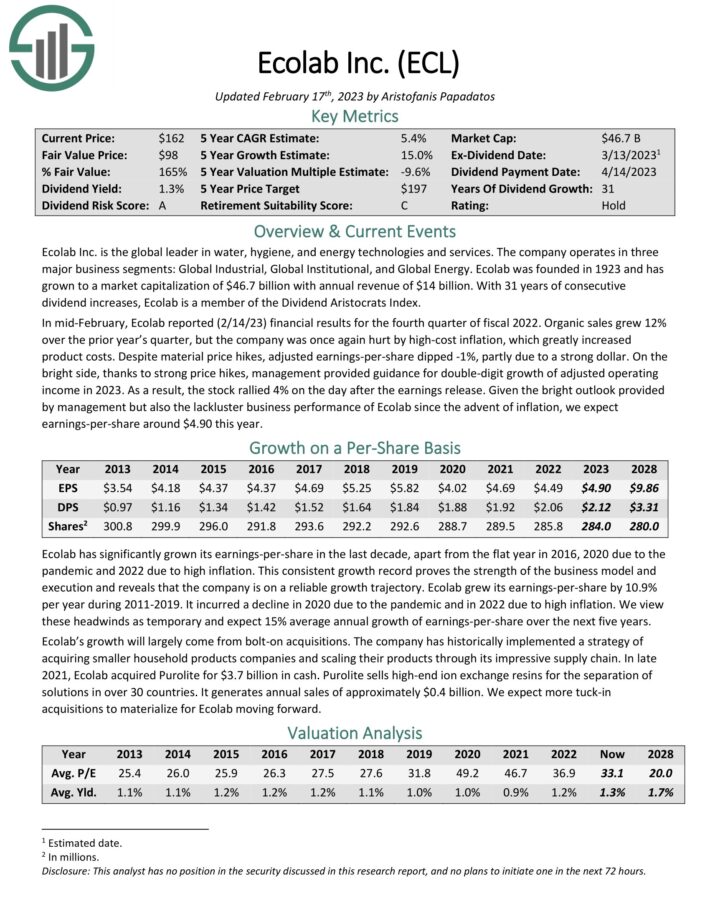
#8—Walmart Inc.
Dividend Yield: 1.6%
Percentage of Bill Gates’ Portfolio: 1.2%
Walmart is another great example of a company with durable competitive advantages. It is the largest retailer in the U.S., with annual revenue above $600 billion. The company came to dominate the retail industry by keeping a laser-like focus on reducing costs everywhere, particularly in supply chain and distribution.
Consumers tend to scale down to discount retail when times are tight, which is why Walmart continued to grow, even during the Great Recession. As a result, Walmart is arguably the most recession-resistant stock in the Gates Foundation’s portfolio.
This allows Walmart the ability to raise its dividend each year like clockwork, even during recessions. Walmart has raised its dividend for over 40 years in a row.
Walmart reported third-quarter earnings on November 15th, 2022, and results were better than expected for both the top and adjusted bottom lines. Total revenue was up 8.8% to $153 billion, powered by comparable sales of +8.2% in the US.
That beat consensus estimates for a gain of 6.9%, as transaction count rose 2.1%, and the average ticket was higher by 6.0%. E-commerce sales were up 16% during the quarter and were 24% higher than in the same quarter of 2020. Sam’s Club sales were up 10.0%, while membership income rose 8.0%.
Click here to download our most recent Sure Analysis report on Walmart (preview of page 1 of 3 shown below):
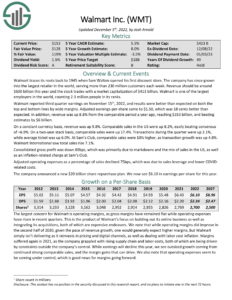
#9—Coca-Cola FEMSA SAB
Dividend Yield: 3.9%
Percentage of Bill Gates’ Portfolio: 1.2%
Coca-Cola FEMSA produces, markets, and distributes Coca-Cola (KO) beverages. It offers the full line of sparkling and still beverages. It sells its products through distribution centers and retailers in Mexico, Guatemala, Nicaragua, Costa Rica, Panama, Colombia, Venezuela, Brazil, Argentina, and the Philippines.
Coca-Cola FEMSA is the largest franchise bottler in the world. The stock is an interesting way to gain exposure to two very attractive emerging markets: Latin America and South Asia.
#10—Waste Connections
Dividend Yield: 0.7%
Percentage of Bill Gates’ Portfolio: 0.8%
Waste Connections is a waste collection, transfer, disposal, and resource recovery business in the U.S. and Canada. It offers various recycling services, including solid waste, as well as fluids used in the oil and gas drilling industry, helping to increase the sustainability of those sectors.
The company was founded in 1997 and is based in Canada, with $7.2 billion in annual revenue, and a market cap of $33 billion.
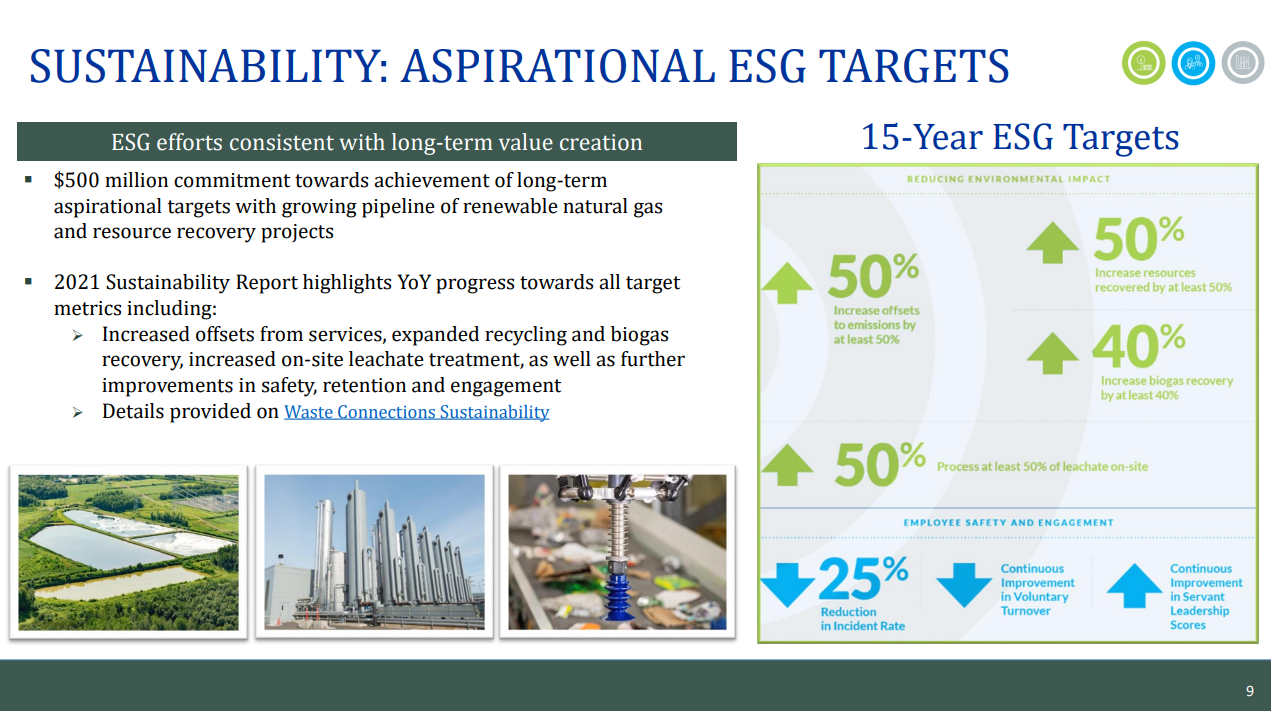
As we can see, Waste Connections has robust ESG targets for the long-term, as it is looking to increase its own sustainability, as well as those of its customers.
Waste Connections has boosted its dividend for six consecutive years, but the strong performance of the stock means the yield is low at just 0.7%. However, we see strong dividend growth prospects for the stock in the years to come.
#11—FedEx
Dividend Yield: 2.2%
Percentage of Bill Gates’ Portfolio: 0.7%
FedEx Corp. is a transportation and shipping company. The company offers a variety of services including transportation, e-commerce, and business services. It operates four core segments: FedEx Express, FedEx Ground, FedEx Freight, and FedEx Services.
On December 20th, 2022, FedEx reported its fiscal Q2 results for the period ending November 30th, 2022. For the quarter, revenues fell 2.9% to $22.8 billion against the prior-year period. FedEx Ground’s operating results were mainly impacted by higher operating expenses, primarily due to increased purchased transportation costs.
In response the company intends to lower capital expenditures to boost shareholder returns.
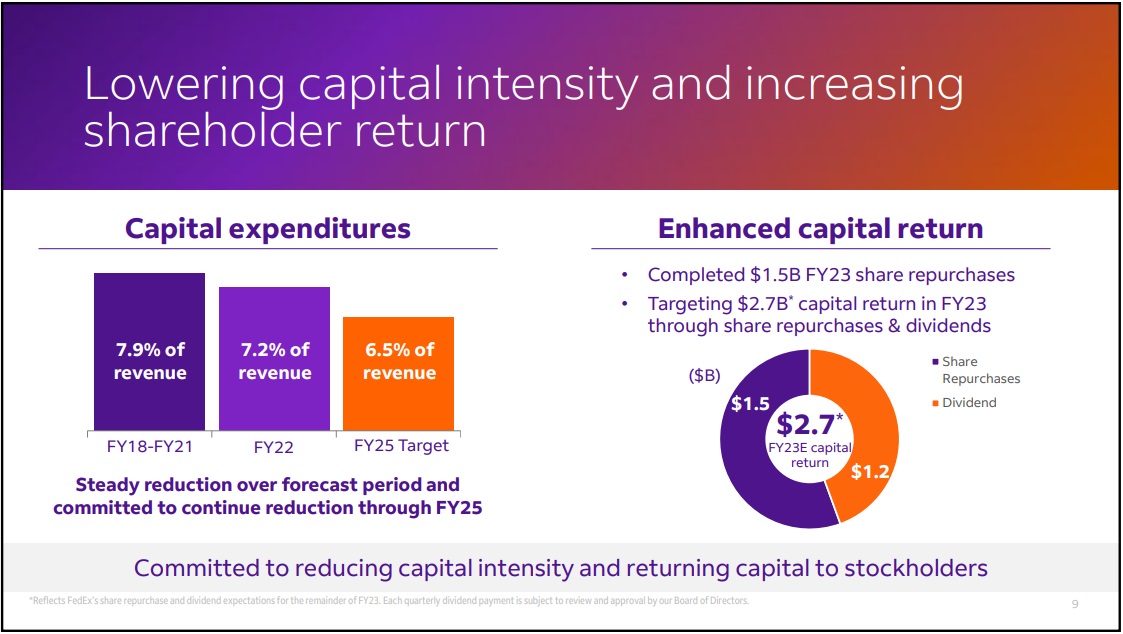
Source: Investor Presentation
The company again managed to increase the segment’s operating income by 24%, driven by higher pricing and a reduction in other costs nonetheless.
However, FedEx Express’ operating income fell 64% due to lower global package and freight volumes, which more than counterbalanced the 8% increase in package yield. Consequently, adjusted earnings-per-share came in at $3.18 compared to $4.83 in the prior-year period. The company now expects adjusted earnings-per-share for fiscal 2023 to be between $13.00 and $14.00.
Click here to download our most recent Sure Analysis report on FedEx (preview of page 1 of 3 shown below):
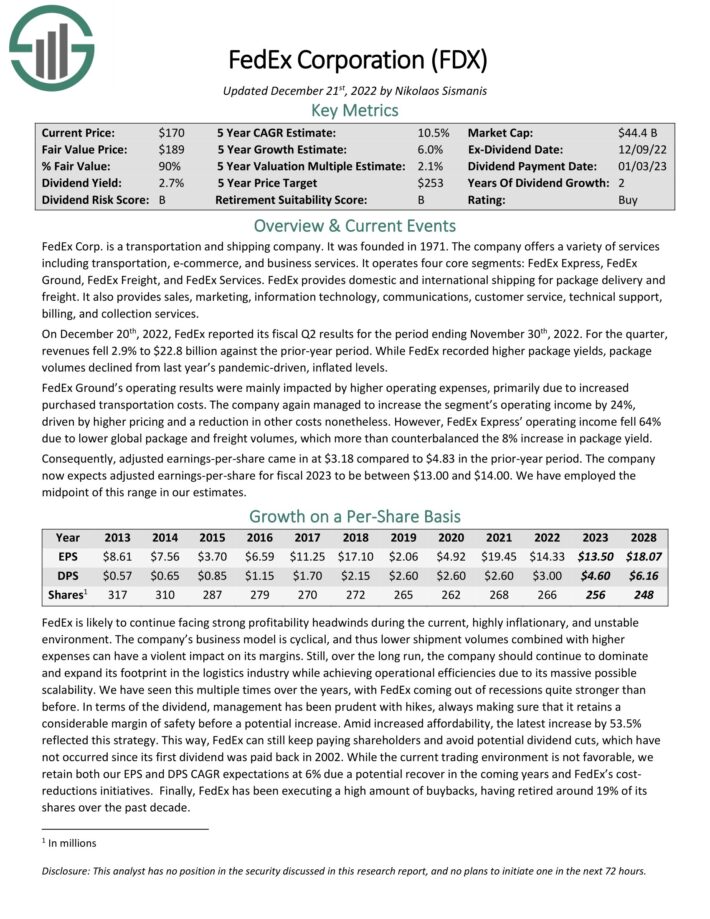
#12—Crown Castle International
Dividend Yield: 4.7%
Percentage of Bill Gates’ Portfolio: 0.5%
Crown Castle International is structured as a real estate investment trust, or REIT. You can see our full REIT list here.
Crown Castle owns cell phone towers with small cells where larger towers are not feasible, and fiber connections for data transmission. The trust owns, operates and leases more than 40,000 cell towers and 75,000 route miles of fiber across every major US market, helping it to support data infrastructure across the country.
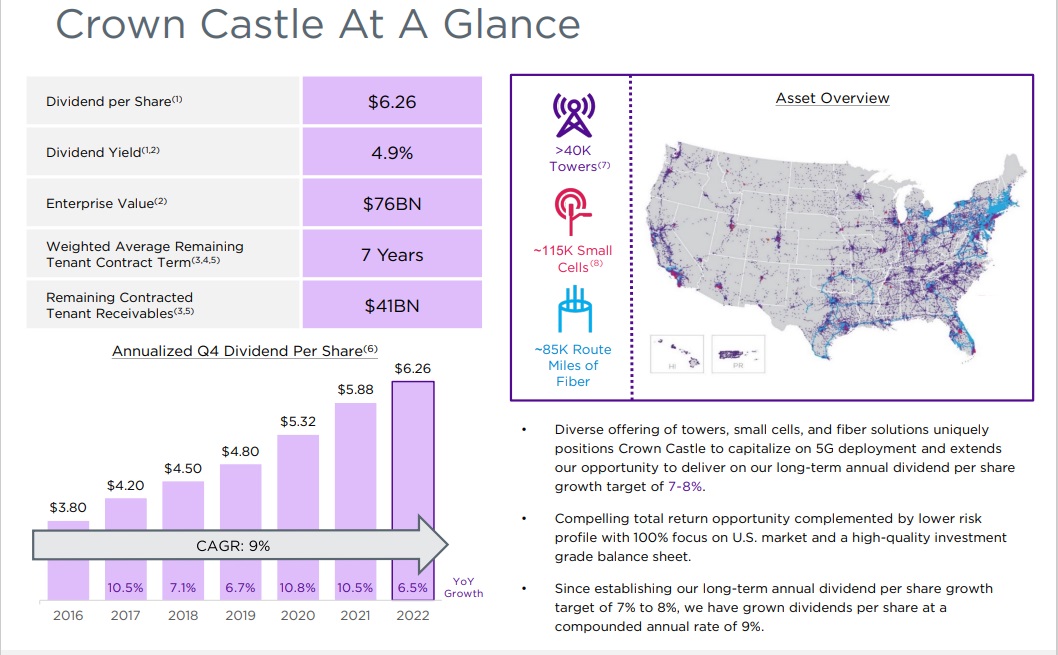
Source: Investor Presentation
Crown Castle reported fourth quarter and full-year earnings on January 25th, 2023, and results were somewhat weak. FFO-per-share was $1.93, which missed estimates by a penny. Revenue was up 6.7% to $1.76 billion year-over-year, and beat estimates narrowly.
Site rental revenue was $1.58 billion, which was up from $1.45 billion in the third quarter, and up from $1.47 billion a year ago. Adjusted EBITDA was $1.09 billion, up from $804 million in Q3, and up from $984 million a year ago. Adjusted FFO-per-share was flat to Q3, and up slightly from last year.
Crown Castle guided for organic revenue growth of 5% for this year, in addition to doubling its small cell deployments from 5k to 10k.
Click here to download our most recent Sure Analysis report on Crown Castle International (preview of page 1 of 3 shown below):
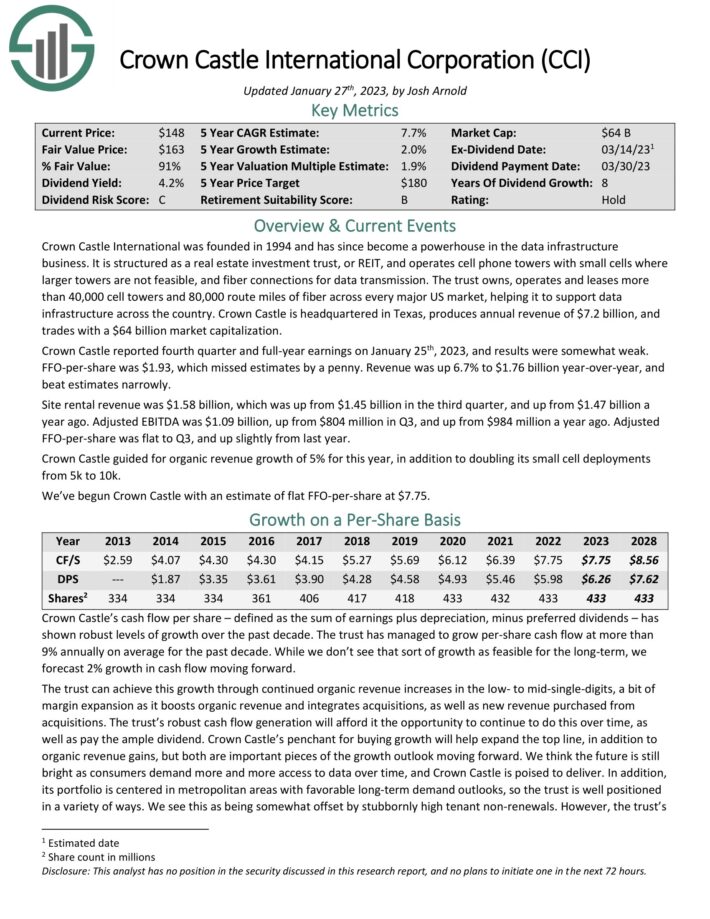
#13—Coupang, Inc.
Dividend Yield: N/A
Percentage of Bill Gates’ Portfolio: 0.4%
Coupang is an e-commerce platform through its mobile apps and websites primarily in South Korea. It sells various products and services in the categories of home goods, apparel, beauty products, fresh food and groceries, sporting goods, electronics, consumables, and more.
#14—Schrodinger Inc.
Dividend Yield: N/A
Percentage of Bill Gates’ Portfolio: 0.4%
Schrodinger, Inc. is a health care technology company. It operates a computational platform that aims to accelerate drug delivery, both for external clients and the company’s own internal drug programs. Schrodinger conducted its initial public offering in February 2020. The stock currently has a market capitalization above $2 billion.
Schrodinger has exciting growth potential, due to the success of its drug delivery platform and its large and diversified customer base.
Schrodinger has a long runway of growth, because of the high degree of value that its products and services provide to customers. Designing drugs is extremely difficult work which is complex, lengthy, capital-intensive, and prone to high failure rates. This means many customers will continue to outsource this work to Schrodinger.
#15—United Parcel Service
Dividend Yield: 3.6%
Percentage of Bill Gates’ Portfolio: 0.36%
United Parcel Service is a logistics and package delivery company that offers services including transportation, distribution, ground freight, ocean freight, insurance and financing. Its operations are split into three segments: U.S. Domestic Package, International Package, and Supply Chain & Freight.
The company’s continued growth in the face of potential global economic headwinds, is due largely to its competitive advantages. UPS is the largest logistics/package delivery company in the U.S.
It operates in a near duopoly, as its only major competitor to date is FedEx. To be sure, Amazon (AMZN) is expanding its own logistics business, but it still remains a customer of UPS as well.
On January 31st, 2023, UPS increased its quarterly dividend by 6.6% to $1.62, marking its 14th consecutive annual increase. The company also reported fourth quarter and full year 2022 results for the period ending December 31st, 2022.
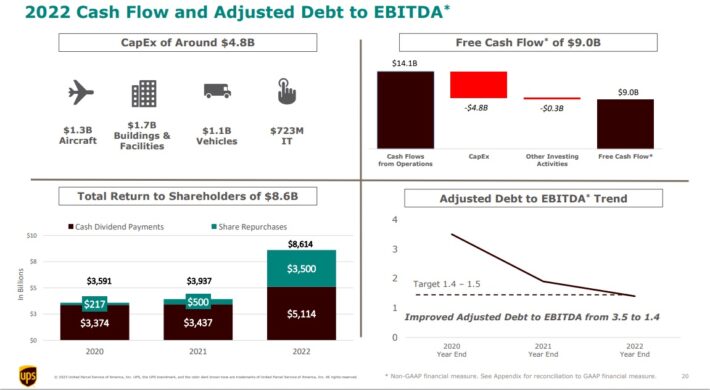
Source: Investor Presentation
For the quarter, the company generated revenue of $27.0 billion, a 2.7% year-over-year decrease.
The U.S. Domestic segment (making up 68% of sales) saw a 3.1% revenue gain, with International posting an 8.3% revenue decrease, and Supply Chain Solutions seeing an 18.1% decrease. Adjusted net income equaled $3.62 per share, up 0.8% year-over-year.
For the full year, revenue rose 3.1% to $100.3 billion and adjusted EPS amounted to $12.94, up 6.7% year-over-year. UPS initiated its 2023 outlook, anticipating revenue between $97.0 billion to $99.4 billion, along with a consolidated adjusted operating margin ranging between 12.8% to 13.6%.
Click here to download our most recent Sure Analysis report on UPS (preview of page 1 of 3 shown below):
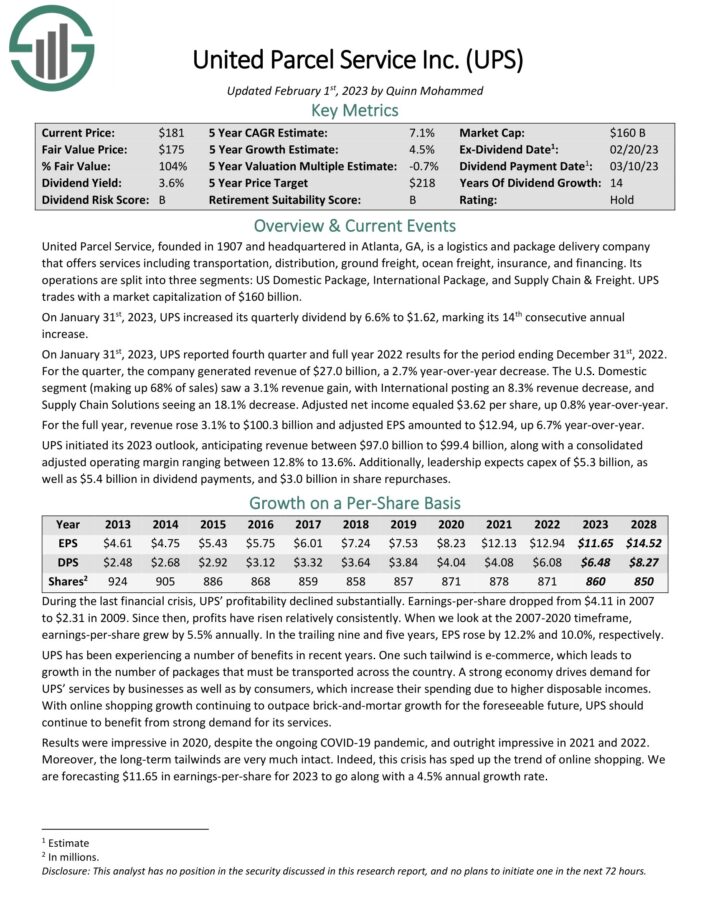
#16—Madison Square Garden Sports Corp.
Dividend Yield: N/A
Percentage of Bill Gates’ Portfolio: 0.30%
Madison Square Garden Sports Corp. is a diversified sports company. It owns multiple sports franchises including the New York Knicks and the New York Rangers. It also owns development league teams such as the Hartford Wolf Pack and the Westchester Knicks of the NBA G League. It also owns e-sports properties including Knicks Gaming and a controlling interest in Counter Logic Gaming (CLG).
#17—Kraft Heinz (KHC)
Dividend Yield: 4.0%
Percentage of Bill Gates’ Portfolio: 0.30%
Kraft–Heinz is a processed food and beverages company which owns aproduct portfolio that includes food products such as condiments, sauces, cheese & dairy, frozen & chilled meals, and infant diet & nutrition. The company was created in 2015 in a merger between Kraft Food Group and H. J. Heinz Company, orchestrated by Berkshire Hathaway and 3G Capital.
The Kraft-Heinz Company reported its third quarter earnings results on October 26. The company reported that its revenues totaled $6.5 billion during the quarter, which was up 3% compared to the revenues that Kraft-Heinz generated during the previous year’s period. This was slightly better than what the analyst community had expected. Kraft-Heinz’ organic sales were up by 12%. Organic sales growth was possible thanks to price increases.
Kraft-Heinz generated earnings-per-share of $0.63 during the third quarter, which easily beat the consensus estimate. Earnings-per-share were down 3% versus the previous year’s quarter, being impacted by a difficult comparison and adverse currency rate movements. Kraft-Heinz’ management stated that they see organic net sales rising at a high-single digits pace in 2022, while management is forecasting EBITDA to come in between $5.9 billion and $6.0 billion during the current year.
Click here to download our most recent Sure Analysis report on Kraft-Heinz (preview of page 1 of 3 shown below):
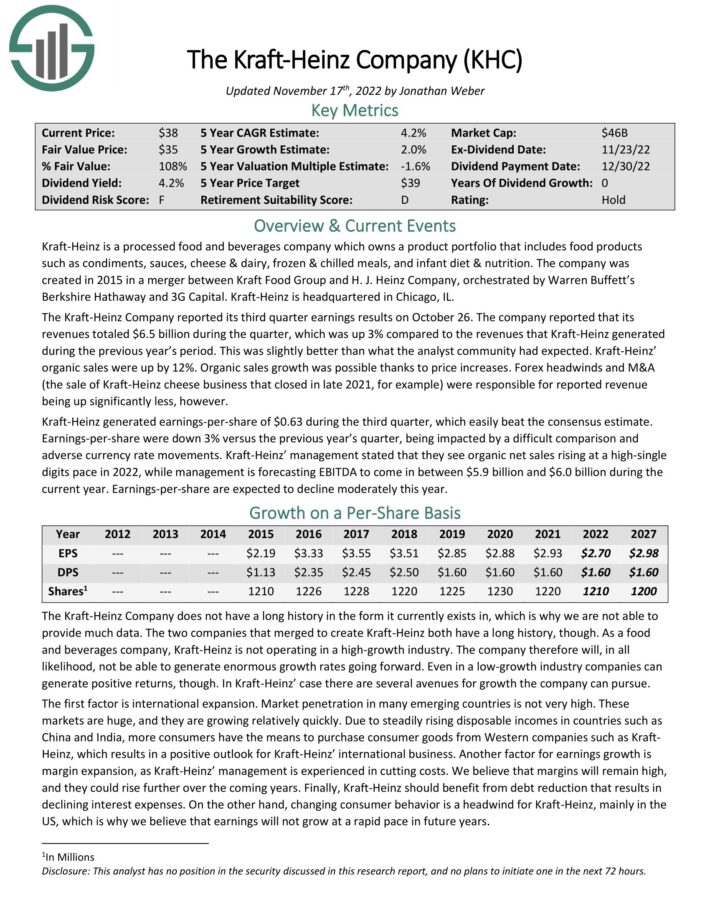
#18—Hormel Foods (HRL)
Dividend Yield: 2.4%
Percentage of Bill Gates’ Portfolio: 0.28%
Hormel Foods was founded in 1891. Since that time, the company has grown into a juggernaut in the food products industry with nearly $10 billion in annual revenue.
Hormel has kept with its core competency as a processor of meat products for well over a hundred years, but has also grown into other business lines through acquisitions.
Hormel has a large portfolio of category-leading brands. Just a few of its top brands include include Skippy, SPAM, Applegate, Justin’s, and more than 30 others.
Hormel reported fourth quarter and full-year earnings on November 30th, 2022, and results were somewhat mixed. Earnings-per-share beat expectations by two cents, coming in at 51 cents. Revenue, however, fell 5% to $3.3 billion, and missed estimates by $50 million.
Organic sales were up 2%, excluding the impact of the additional week that was present in the prior year’s fourth quarter. Operating income was $367 million, up 3%. Operating margin was 11.2%, which was 80 basis points higher than last year’s Q4. Earnings-per-share were flat at 51 cents.
Cash flow from operations came to $372 million, down 34% year-over-year. The company said it expects to see volatile costs and sales for the foreseeable future given supply chain constraints and inflationary pressures.
Click here to download our most recent Sure Analysis report on Hormel (preview of page 1 of 3 shown below):
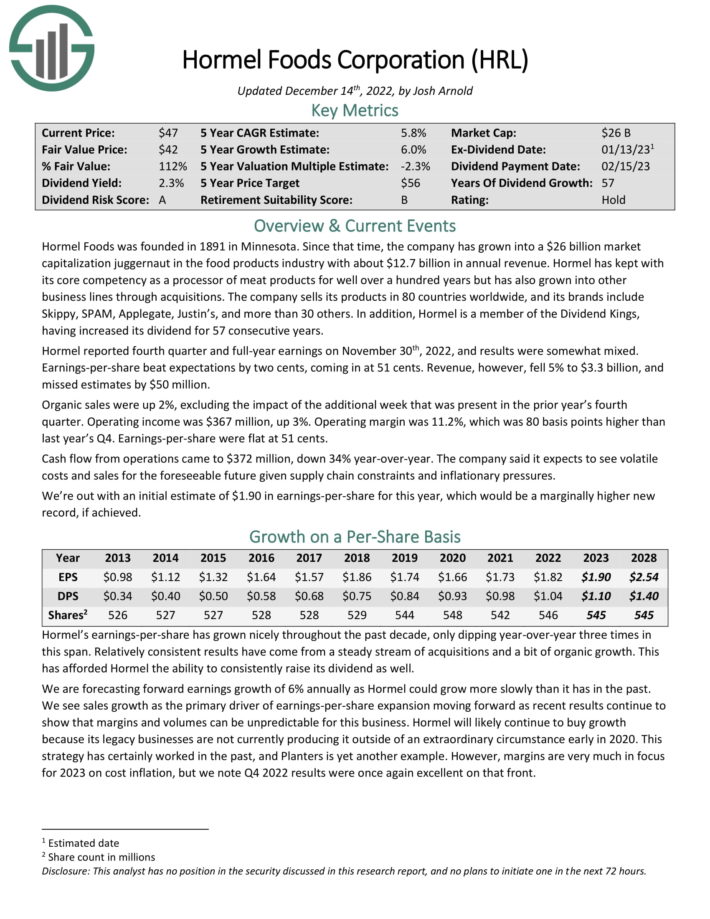
#19—Danaher Corporation (DHR)
Dividend Yield: 0.421%
Percentage of Bill Gates’ Portfolio: 0.28%
Danaher Corporation is active in the healthcare industry and designs, manufactures and markets professional, medical, industrial, and commercial products and services. The company operates through three main segments: Life & Bio Sciences (38% of annual revenue – end of 2022), Diagnostics (35% of annual revenue), and Environmental & Applied Solutions (15% of annual revenue). The company made 14 acquisitions in 2021 for a total of $11.0 billion, including the Aldevron acquisition of $9.6 billion.
On January 24th, 2023, Danaher Corporation released its fourth quarter fiscal 2022 results for the period ending December 31st, 2022. For the quarter the company reported revenue of $8.37 billion which represents a 2.7% increase compared with revenue of $7.58 billion in the same quarter of 2021.
Revenue from the Life Sciences segment totaled $1.95 billion, rising 7.9% year-over-year. Revenue from the Diagnostics segment grossed $2.965 billion, increasing 7.5% year-over-year. Revenue from the Environmental & Applied Solutions segment totaled $1.235 billion, up 5.5% year-over-year. Revenues from the Biotechnology segment totaled $2,223 million, down nearly 1% year over year.
Reported quarterly earnings per diluted share equaled $2.87 which represents a 6.5% increase over the comparable 2021 period. For the full year 2022, net earnings were $7.1 billion, or $9.66 per diluted common share which represents a 13.5% year-over-year increase.
For the first quarter 2023, the management anticipates that core revenue growth will be around 5%. For the full year of 2023, the company expects that core revenue growth will be in the high-single-digit percent range. Organic sales growth is estimated to increase in mid-single digits in the first quarter and the full year.
Click here to download our most recent Sure Analysis report on Danaher (preview of page 1 of 3 shown below):
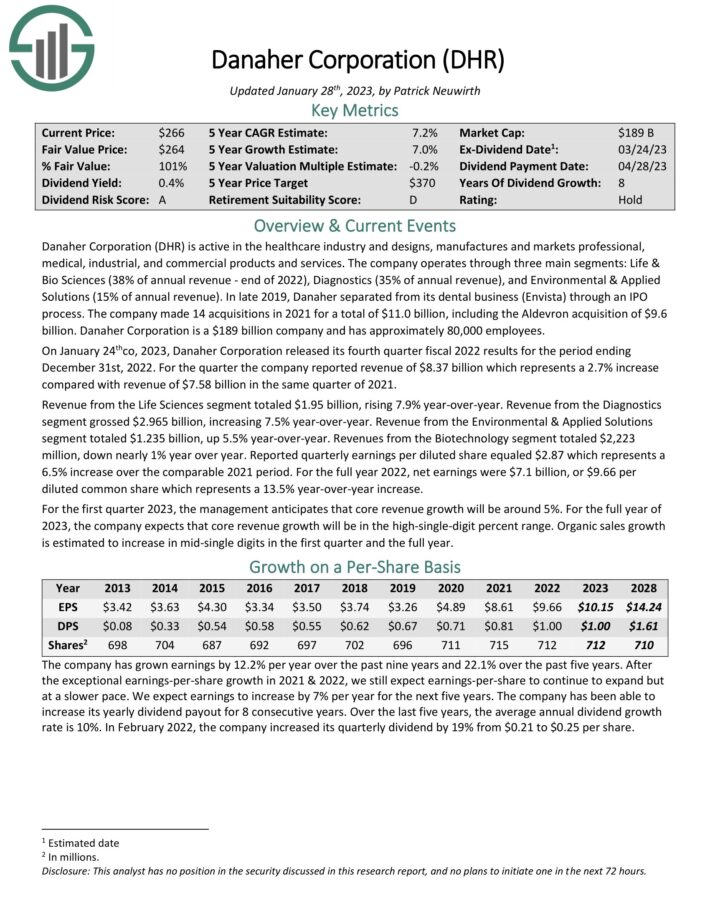
#20—On Holding AG
Dividend Yield: N/A
Percentage of Bill Gates’ Portfolio: 0.02%
On Holding is based in Switzerland and it develops and distributes sports products worldwide. It offers its products through independent retailers and distributors, online, and stores.
#21—Carvana Co.
Dividend Yield: N/A
Percentage of Bill Gates’ Portfolio: 0.01%
Carvana is an e-commerce platform for buying and selling used cars in the United States. The company’s platform allows customers to research, inspect, obtain financing for and purchase vehicles from their desktop or mobile devices.
#22—Vroom, Inc. (VRM)
Dividend Yield: N/A
Percentage of Bill Gates’ Portfolio: 0.01%
Vroom operates as an e-commerce used automotive retailer in the United States. It operates an end-to-end e-commerce platform for buying, selling, transporting, and delivering vehicles.
This article was first published by Bob Ciura for Sure Dividend
Sure dividend helps individual investors build high-quality dividend growth portfolios for the long run. The goal is financial freedom through an investment portfolio that pays rising dividend income over time. To this end, Sure Dividend provides a great deal of free information.
Related:
All 47 Warren Buffett Portfolio Stocks Now | Current 2023 Holdings List
2023 Kevin O’Leary Complete Stock Portfolio List & Top 10 Dividend Picks Now

